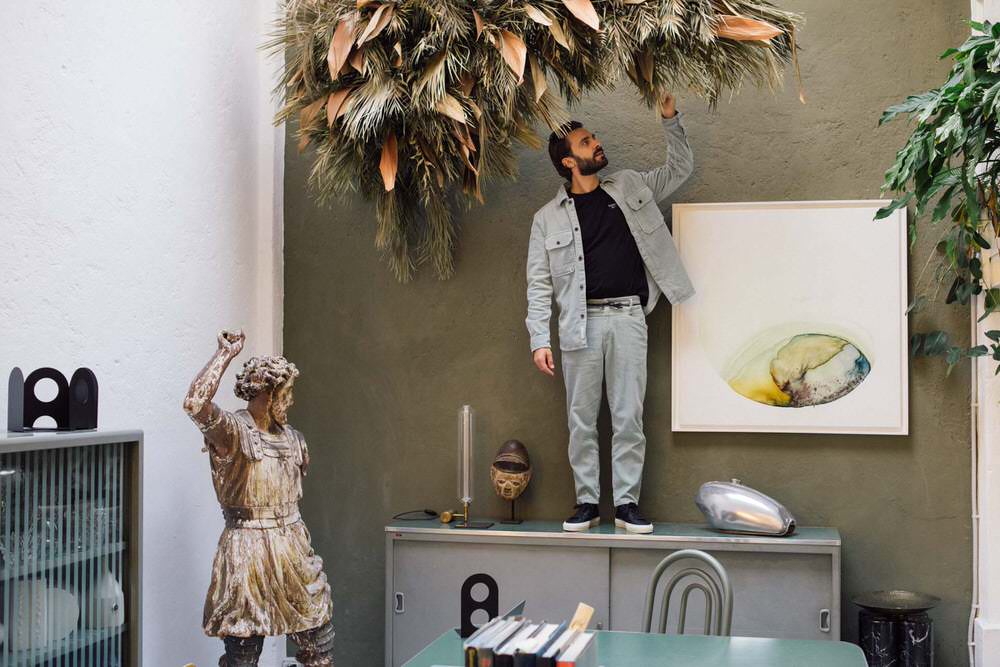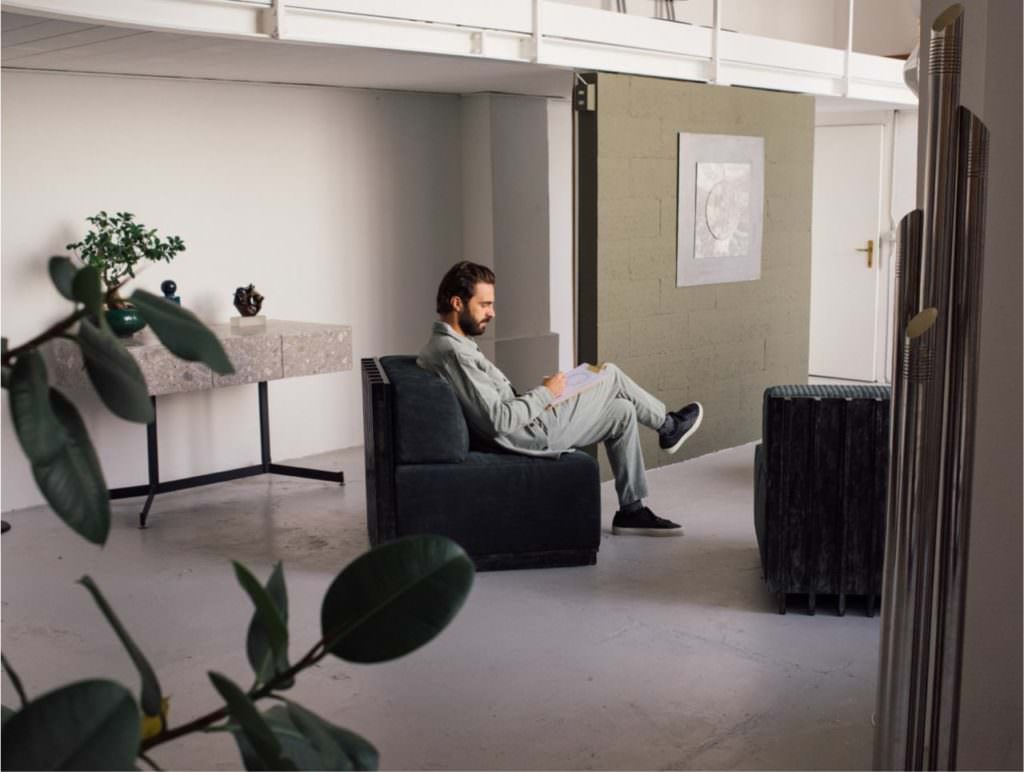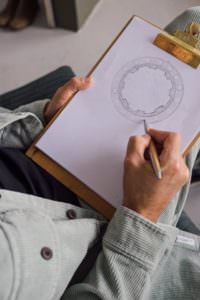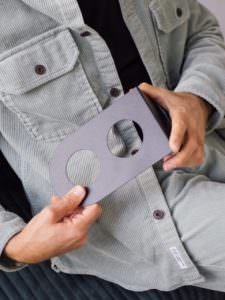After living in Australia and New York, the Italian interior and furniture designer Tommaso Spinzi now believes that his pieces can exist almost nowhere else but in his hometown Milan. With his studio Spinzi Designs, he aims to create meaningful environments that are stimulating, drawing inspiration from Milan’s cultural and industrial heritage and his own neighborhood: the lively Isola district, which could also be called the heart of the Milanese design scene. His white 1983 Porsche 911SC is parked inside his studio – because it’s much more than a car to him: he loves staring at its lines, which helps him find focus. In our interview, Tommaso talks about the mid-century furniture he collects, shares his favourite spots in Milan and some interior advice.
How would you describe your path to becoming an interior and furniture designer?
It all started with my personal passion. My interest in vintage furniture, especially mid-century and industrial, led me to the world of design. I wanted to create objects, spaces and atmospheres as fascinating and appealing as the pieces I collected.
How have you experienced this year so far?
I am a very dynamic person, so the stop imposed by the lockdown in Italy has been rather difficult to accept. On the other hand, I took the time to work on new projects and to experiment with new forms of expression. Everyday objects that surround me at home or in my atelier inspire most of what I design now.
Being forced to stay at home, I looked at the nature and surrounding of my place on Lake Como with different eyes. During quarantine, I translated those calm and contemplative landscapes into a series of abstract paintings.
How does Milan, your city, inspire you?
Milan is an extremely dynamic and contemporary city, but it also has a rich cultural and industrial heritage – which is summed up in all my creations. I would even say that my pieces couldn’t exist anywhere else but in Milan.
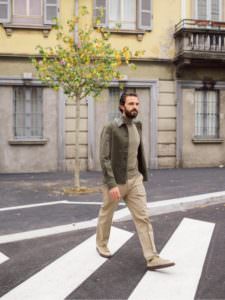 Which are your favourite spots in Milan?
Which are your favourite spots in Milan?
I enjoy staying in my atelier, a space that I have tailored to my taste and needs. When I am not there, you can find me strolling around Affori, with its charming residences, or in the streets of Isola, seeking inspiration. I like the occasional drink at Bar Basso or at Arabesque, a cool concept bar just meters away from Piazza Duomo.
Which neighbourhood of Milan do you live in and how would you describe it?
I live in Isola, possibly the heart of the Milanese design scene. The district has completely changed its face over the last ten years or so, and is now one of the most lively and creative areas of Milan.
What do you especially like about Milan?
I love the fact that it is a cosmopolitan city, but at the same time, it is deeply Italian. It is a place where technology, heritage, craftsmanship, style and taste blend together perfectly, making the city truly unique.
And what do you only find at lake Como?
Relaxation and escape from the chaos of the city, two of the most important things for my creative process. The atmosphere of the lake, its reflections and the beautiful colours all add up in a way that would not be possible elsewhere.
How has living in Switzerland, Australia and New York influenced you?
Living abroad has been fundamental to my development – both as a man and a designer. But most importantly, I realized how special Italy is, and I learned to appreciate the Italian way – fashion, craftsmanship, architecture, entrepreneurship… It’s very unique.
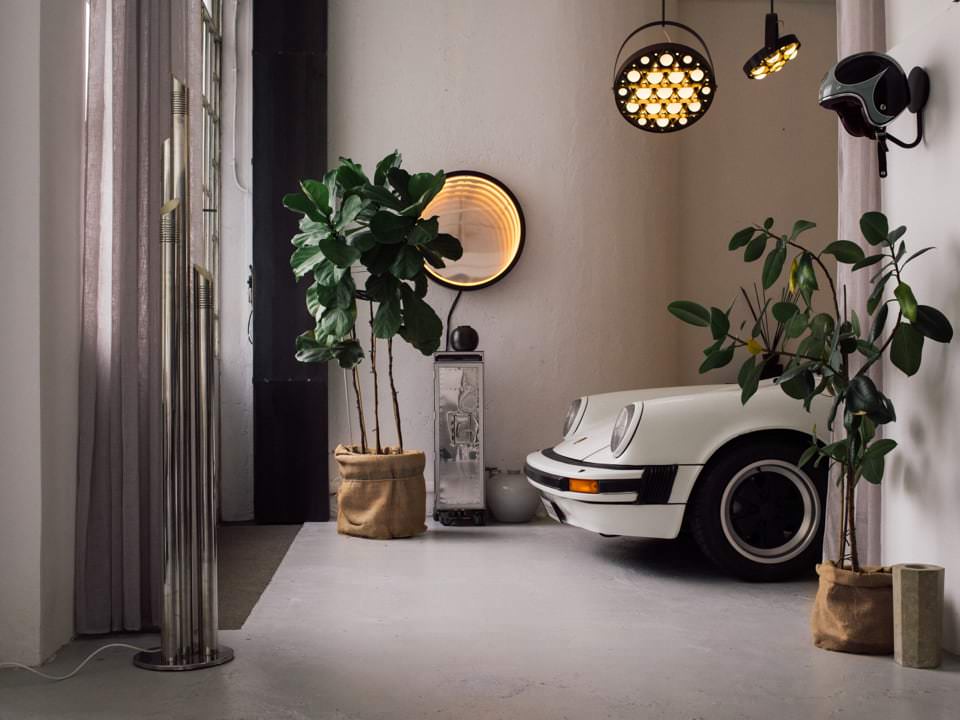 When did you start collecting Italian mid-century furniture?
When did you start collecting Italian mid-century furniture?
It was in my early twenties, when I starting hitting flea markets and stock sales around Como and Milan. The industrial lines I saw around me have always fascinated me. So buying furniture that reminded me of them was a natural consequence.
What fascinates you about this period?
It is about how designers have been able to create elegant and refined objects, drawing inspiration from industrial aesthetics. For the first time in history, the beauty of pure lines and shapes replaced decoration.
Which is the most special piece in your furniture collection?
I am obsessed with vintage Murano glass… vases, lamps, ashtrays. There is not a single specific piece I prefer – I love them all. Every time I find one that says something to me, I just have to buy it.
How would you describe the style of your own apartment? Which role do collectibles play?
It is definitely an eclectic space, where styles and influences mix in a constant dialogue. What I look for is the “wunderkammer” effect, so collectibles play a key role in the definition of this atmosphere.
When did you start collecting cars and motorbikes and how big is your collection?
I raced motorcycles with friends in my teen years. We were always swapping parts and trading bikes and cars. Later on, I started collecting cars and motorcycles. The white Porsche in my studio is a 1983 911SC, powered by one of the last air-cooled boxer-six engines to be made in the Stuttgart factory. It is an object of pure beauty, and I love staring at its lines – it helps me focus. That is why I keep it parked in the studio.
 What is your most important interior design advice?
What is your most important interior design advice?
Do not be afraid to mix elements from different cultures or styles. The interior of our home is where we spend our most valuable time, so it should be a sheer reflection of our passions, inclinations and taste.
What is important to you when it comes to fashion?
As in my design, I like to play with the tones of my outfit, pairing similar colors and neutral tones. I like to keep it simple, but I pay great attention to quality and detail. That’s how you build a lasting and defining style.
The top 3 essentials in your closet?
Designer sneakers, heavy cotton overshirts and a tote bag that follows me everywhere I go.
Original article on Closed



